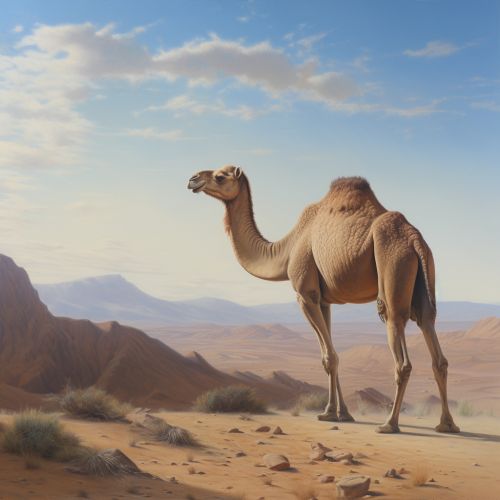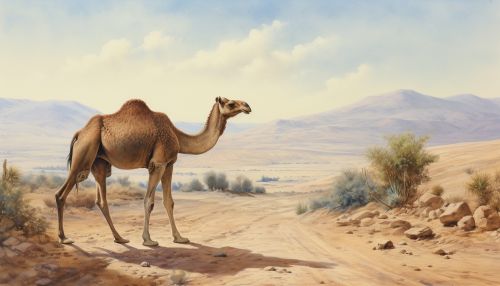Camelus dromedarius
Taxonomy and Naming
The Camelus dromedarius, commonly known as the Dromedary camel or Arabian camel, belongs to the genus Camelus within the family Camelidae. The species name dromedarius is derived from the Greek word dromas, meaning "a runner", reflecting the camel's notable ability for sustained fast movement.


Description and Anatomy
The dromedary camel is a large mammal, with males typically reaching a height of 1.8 to 2 meters at the shoulder and weighing between 400 and 600 kilograms. Females are slightly smaller. The most distinctive feature of the dromedary camel is its single hump, which is used to store fat that can be metabolically converted into water and energy during periods of scarcity. This adaptation is crucial for survival in the arid environments where dromedaries are typically found.
The camel's coat is generally a sandy color, which serves as camouflage in the desert environment and reflects sunlight to prevent overheating. The coat is shed completely each year. Dromedaries have long, slender legs with broad, tough feet that are adapted for travel across sandy or rocky terrain. They also possess a double row of long eyelashes and sealable nostrils to protect against blowing sand.
Distribution and Habitat
Dromedary camels are native to the arid regions of the Middle East and North Africa, but have been introduced to other arid and semi-arid regions around the world, including Australia, where they now exist in large feral populations. They are well adapted to desert conditions, able to withstand extreme temperatures ranging from freezing cold to over 40 degrees Celsius.
Diet and Behavior
Dromedaries are herbivores, feeding on a variety of plant materials including leaves, stems, and seeds. They are able to consume thorny, dry, or salty plants that are inedible to many other herbivores. This dietary flexibility allows them to survive in environments with sparse vegetation.
Dromedaries are known for their ability to go without water for long periods, up to several weeks in cool weather, although they drink large quantities when water is available. Contrary to popular belief, the camel's hump does not store water; it stores fat, which can be metabolized to produce both water and energy.
Reproduction and Lifecycle
Dromedary camels have a gestation period of approximately 13 months, typically resulting in the birth of a single calf, although twins are occasionally born. Calves are able to stand and run shortly after birth, an important survival trait in the harsh environments where dromedaries live.
Domestication and Uses
Dromedary camels have been domesticated for thousands of years and are used for a variety of purposes including transportation, milk production, and meat production. They are highly valued for their ability to carry heavy loads over long distances without requiring much water or food.
Conservation Status
The dromedary camel is not currently considered a threatened species. However, like all species, it faces threats from habitat loss and climate change.
